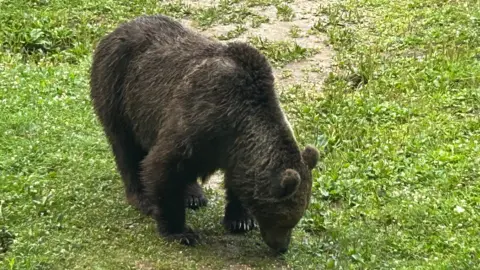 BBC
BBCOn 9 July, Diana Cazacu, a 19-year-old hiker, was mauled to death by a young female bear in the Bucegi mountains north of Bucharest. In response, the government overturned a 2016 moratorium on bear hunting – and reignited a fierce debate about what to do with Romania’s growing bear population, the largest in Europe outside Russia.
The staff at the Salvamont headquarters, Romania’s mountain rescue service, radiate calm and efficiency.
When Diana and her boyfriend rang the emergency number, 112, in panic at 15:00 on 9 July, the call was transferred here.
Sergiu Frusinoiu, in charge that day, set out immediately with two teams. One approached the incident spot from above, the other from below. Bears rarely attack humans, except in self-defence – so Sergiu assumed this would be a simple rescue mission.
At the scene they found the woman’s distraught boyfriend. The bear had grabbed Diana, and thrown her down the ravine. They descended by rope, and found the bear standing over the victim.
The bear attacked the rescue team, who defended themselves with pepper spray, firecrackers and rocks, until a hunter arrived and shot the bear. It was too late for Diana, lying on her stomach, her head in the stream.
“Even if the fall or her injuries didn’t kill her, the water could have,” Sergiu told me.
He said Diana’s mistake had been to run away when faced with the bear. Sergiu grew up in these mountains, and has had hundreds of encounters with bears, without incident, he said.

The standard advice is to make noise in bear territory as you walk. If you encounter a bear, stand quiet and still, then back slowly away. As with a dog, the worst thing you can do is run away, as it is sure to follow.
At the base of the footpath which Diana climbed that day, it becomes clear why the bear was on the path. Three large municipal waste bins, the remains of a cage around one, stand open to the sky. One has been tipped over, and there is rotting food, tins and plastic strewn over a wide area.
Around 8,000 bears live in the arc of the Carpathian mountains, one of Europe’s last wilderness regions, their habitat constantly eroded by logging, the spread of towns, and tourism.
In the nearby town of Busteni, at seven in the evening, I get a bear alert on my phone, and rush to the scene, a residential street.
Angry locals say they’re afraid to walk home at night, because of the bears.
The police arrive, and the locals harangue them for doing too little. “But what do you want us to do?” asks a young officer. “Keep us safe!” shouts one man.
I get through to the hunter who shot the bear who killed Diana, but he says he will not speak until the inquest is over.
Former Environment Minister Barna Tanczos is the author of the new law, passed by the Chamber of Deputies and approved by President Klaus Iohannis in July, that allows people to kill up to 500 bears over the next 18 months .
“The bear population is increasing daily, monthly, yearly in Romania, so if we don’t do something we will have thousands, tens of thousands of bears, which is not good for humans, and not good for the bears,” Mr Tanczos said.
“So we have to establish control, we need a balance in human – bear relations, and conflicts, and contacts.”

According to Cristi Remus Papp, head of the large carnivore department of the Worldwide Fund for Nature, the new law will do nothing to improve the situation, and could make it worse.
There is a growing number of “troublesome” bears, he admits, but there are no accurate statistics for how many bears there are overall.
In any case, the number is not the point, he says: “We have to address the root causes of the conflicts, starting with the mass feeding of bears close to settlements, and along the roads in tourist areas.”
Since the communist era, hunters’ associations are obliged by law to feed the bears – a practice initially meant to make them easier to shoot, and keep them out of towns, but is now partly done for tour operators, who want to guarantee a sighting of bears to their clients.
Social media feeds are full of video clips of tourists feeding bears from their cars. A future change in the law could be to fine those who do so.
Other bear management methods have been tried with some success – like tranquillising and removing bears to wild areas of the mountains. But now that bears have got into the habit of raiding bins or begging for food, even conservationists say there may be no alternative to culling them.
One example of good practice is the town of Baile Tusnad.
“In 2021 we had 220 bear alerts. This year so far, only 3,” Zsolt Butyka, the mayor told me proudly. His municipality bought 14 neat, stainless steel bear-proof bins, cut down 50 fruit trees in the town, and ran regular bear awareness campaign for the public.
A poster near the town hall reads: “If you feed a bear, you kill a bear.”

The town is on a main migration route for bears, across the Olt river valley, but now they skirt round the edges. “They’ve learnt there’s nothing for them here,” the mayor tells me.
On a sultry summer evening, Janos Szin, a tour operator who runs a number of bear hides in the Tusnad area, sends me the map coordinates where to wait. A forest ranger in a four-wheel drive picks me up.
Once we’re installed behind a large glass window in a raised hide, he produces a sack and scatters maize. The bears arrive while he is still there – two females, one with three cubs. After a while, a large male ambles up, and the others scatter. He climbs onto the scales, disguised as a feeding trough, and we see his weight: 240 kg (37 stone).
In a phone conversation, Mr Szin tells me the law is bad.
The “wrong bears” will be killed – the large males, minding their business up in the mountains. These males help keep the population down, he says, because they kill the cubs, so they can mate with their mothers.
This is a common practice among lions in the wild, but experts disagree about its prevalence among bears.
Poachers, trying to steal bear cubs, are another problem, Mr Szin suggests.
He’s afraid that hunters from all over the world will now flock to Romania – the only place where they can bag a bear pelt and a skull, to hang on their walls.









